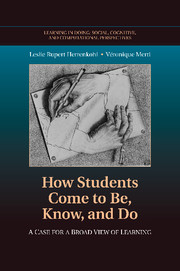Book contents
- Frontmatter
- Contents
- Series Foreword
- Acknowledgments
- How Students Come to Be, Know, and Do
- Introduction
- 1 The Context Lens
- 2 How Ways of Knowing, Doing, and Being Emerged in the Classroom: Interpersonal Interactions and the Creation of Community, Part I
- 3 How Ways of Knowing, Doing, and Being Emerged in the Classroom: Interpersonal Interactions and the Creation of Community, Part II
- 4 Personal Lens of Analysis: Individual Learning Trajectories
- Conclusion
- References
- Index
- Titles in the series
Introduction
Published online by Cambridge University Press: 06 December 2010
- Frontmatter
- Contents
- Series Foreword
- Acknowledgments
- How Students Come to Be, Know, and Do
- Introduction
- 1 The Context Lens
- 2 How Ways of Knowing, Doing, and Being Emerged in the Classroom: Interpersonal Interactions and the Creation of Community, Part I
- 3 How Ways of Knowing, Doing, and Being Emerged in the Classroom: Interpersonal Interactions and the Creation of Community, Part II
- 4 Personal Lens of Analysis: Individual Learning Trajectories
- Conclusion
- References
- Index
- Titles in the series
Summary
A true and complex understanding of another's thought becomes possible only when we discover its real, affective-volitional basis.
(Vygotsky, 1987/1934, p. 282)…with respect to the aims of education, no separation can be made between impersonal, abstract principles of logic and the moral qualities of character. What is needed is to weave them into unity.
(Dewey, 1933, p. 34)To say that the past 50 years has brought rapid advances in science, engineering, and technology is an understatement. Life expectancies have increased from 68 years in 1950 to 78 years in 2004. Engineering takes place on a miniscule scale, 1/100,000th the diameter of a human hair. Regular communication for business and pleasure, once the purview of the telephone and U.S. mail system, now takes place through e-mail and online video conferencing. However, in the midst of unstoppable progress in science and technology, one thing has remained the same. European-American women and people of color continue to choose physical science, engineering, and technology careers at much lower rates than European-American men. The question is why?
Lack of access to knowledge and skills is the most common explanation for why European-American women and people of color do not choose physical science, engineering, and technology-related careers. Some believe that increasing access to key coursework and knowledge will shift career choices among underrepresented groups. However, over the past 25 years, attempts to increase access to knowledge has not led to appreciable change in the population of people choosing career paths in science, engineering, and technology.
- Type
- Chapter
- Information
- How Students Come to Be, Know, and DoA Case for a Broad View of Learning, pp. 1 - 26Publisher: Cambridge University PressPrint publication year: 2010
- 1
- Cited by

